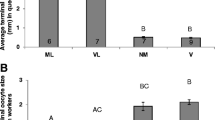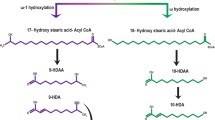Abstract
In the honeybee, Apis mellifera, the queen monopolizes reproduction, while the sterile workers cooperate harmoniously in nest maintenance. However, under queenless (QL) conditions, cooperation collapses and reproductive competition among workers ensues. This is mediated through aggression and worker oviposition, as well as shifts in pheromones, from worker to queen-like composition. Many studies suggest a dichotomy between conflict resolution through aggression or through pheromonal signaling. In this paper, we demonstrate that both phenomena comprise essential components of reproductive competition and that pheromone signaling actually triggers the onset of aggression. We kept workers as QL groups until first aggression was observed and subsequently determined the contestants’ reproductive status and content of the mandibular (MG) and Dufour’s glands (DG). In groups in which aggression occurred early, the attacked bee had consistently more queen-like pheromone in both the MG and DG, although both contestants had undeveloped ovaries. In groups with late aggression, the attacked bee had consistently larger oocytes and more queen-like pheromone in the DG, but not the MG. We suggest that at early stages of competition, the MG secretion is utilized to establish dominance and that the DG provides an honest fertility signal. We further argue that it is the higher amount of DG pheromone that triggers aggression.



Similar content being viewed by others
References
Anderson RH (1963) The laying worker in the Cape honeybee, Apis mellifera capensis. J Apic. Res 2:85–92
Bloch G, Hefetz A (1999) Reevaluation of the role of mandibular glands in regulation of reproduction in bumblebee colonies. J Chem Ecol 25:881–896
Crewe RM, Velthuis HHW (1980) False queens: a consequence of mandibular gland signals in worker honeybee. Naturwissenschaften 67:467–469
Cuvillier-Hot V, Cobb M, Malosse C, Peeters C (2001) Sex, age and ovarian activity affect cuticular hydrocarbons in Diacamma ceylonense, a queenless ant. J Insect Physiol 47:485–493
Cuvillier-Hot V, Gadagkar R, Peeters C, Cobb M (2002) Regulation of reproduction in a queenless ant: aggression, pheromones and reduction in conflict. Proc R Soc Lond B 269:1295–1300
De Biseau JC, Passera L, Daloze D, Aron S (2004) Ovarian activity correlates with extreme changes in cuticular hydrocarbon profile in the highly polygynous ant, Linepithema humile. J Insect Physiol 50:585–593
D’Ettorre P, Heinze E, Schulz C, Francke W, Ayasse M (2004) Does she smell like a queen? chemoreception of a cuticular hydrocarbon signal in the ant Pachycondyla inversa. J Exp Biol 207:1085–1091
Dietemann V, Peeters C, Liebig J, Thivet V, Holldobler B (2003) Cuticular hydrocarbons mediate discrimination of reproductives and nonreproductives in the ant Myrmecia gulosa. Proc Natl Acad Sci U S A 100:10341–10346
Dietemann V, Neumann P, Hartel S, Pirk CWW, Crewe RM (2007) Pheromonal dominance and the selection of a socially parasitic honeybee worker lineage (Apis mellifera capensis Esch). J Evol Biol 20:997–1007
Dor R, Katzav-Gozansky T, Hefetz A (2005) Dufour’s gland pheromone as a reliable fertility signal among honeybee (Apis mellifera) workers. Behav Ecol Sociobiol 58:270–276
Endler A, Liebig J, Schmitt T, Parker JE, Jones GR, Schreier P, Holldobler B (2004) Surface hydrocarbons of queen eggs regulate worker reproduction in a social insect. Proc Natl Acad Sci U S A 101:2945–2950
Gobin B, Ruppell O, Hartmann A, Jungnickel H, Morgan ED, Billen J (2001) A new type of exocrine gland and its function in mass recruitment in the ant Cylindromyrmex whymperi (Formicidae,Cerapachyinae). Naturwissenschaften 88:395–399
Greeff JM (1996) Effects of thelytokous worker reproduction on kin selection and conflict in the Cape honeybee, Apis mellifera capensis. Philos Trans R Soc Lond B 351:617–625
Hammond RL, Keller L (2004) Conflict over male parentage in social insects. PLoS Biol 2:1472–1482
Hannonen M, Sledge MF, Turillazzi S, Sundstrom L (2002) Queen reproduction, chemical signaling and worker behaviour in polygyne colonies of the ant Formica fusca. Anim Behav 64:477–485
Hoover SER, Keeling CI, Winston ML, Slessor KN (2003) The effect of queen pheromones on worker honey bee ovary development. Naturwissenschaften 90:477–480
Inbar S, Katzav-Gozansky T, Hefetz A (2008) Kin composition effects on the reproductive competition among queenless honeybee workers. Naturwissenschaften. DOI 10.1007/s00114-008-0343-6
Katzav-Gozansky T (2006) The evolution of honeybee multiple queen-pheromones: a consequence of a queen–worker arms race? Braz J Morphol Sci 23:129–136
Katzav-Gozansky T, Soroker V, Hefetz A, Cojocaru M, Erdmann DH, Francke W (1997) Plasticity of caste-specific Dufour’s gland secretion in the honey bee (Apis mellifera L.). Naturwissenschaften 84:238–241
Katzav-Gozansky T, Boulay R, Soroker V, Hefetz A (2004) Queen-signal modulation of worker pheromonal composition in honeybees. Proc R Soc Lond B 271:2065–2069
Katzav-Gozansky T, Boulay R, Soroker V, Hefetz A (2006) Queen pheromones affecting the production of queen-like secretion in workers. J Comp Physiol 192:737–742
Keller L, Nonacs P (1993) The role of queen pheromones in social insects: queen control or queen signal? Anim Behav 45:787–794
Le Conte Y, Hefetz A (2008) Primer pheromones in social Hymenoptera. Annu Rev Entomol 53:26.1–26.15
Liebig J, Peeters C, Oldham NJ, Markstadter C, Holldobler B (2000) Are variations in cuticular hydrocarbons of queens and workers a reliable signal of fertility in the ant Harpegnathos saltator? Proc Natl Acad Sci U S A 97:4124–4131
Malka O, Shnieor S, Hefetz A, Katzav-Gozansky T (2007) Reversible royalty in worker honeybees (Apis mellifera) under the queen influence. Behav Ecol Sociobiol 61:465–473
Monnin T, Peeters C (1998) Monogyny and regulation of worker mating in the queenless ant Dinoponera quadriceps. Anim Behav 55:299–306
Monnin T, Ratnieks FLW (1999) Reproduction versus work in queenless ants: when to join a hierarchy of hopeful reproductives? Behav Ecol Sociobiol 46:413–422
Moritz RFA, Simon UE, Crewe RM (2000) Pheromonal contest between honeybee workers (Apis mellifera capensis). Naturwissenschaften 87:395–397
Moritz RFA, Lattorff HMG, Crewe RM (2004) Honeybee workers (Apis mellifera capensis) compete for producing queen-like pheromone signals. Proc R Soc Lond B 271:S98–S100
Neumann P, Hepburn HR (2002) Behavioural basis for social parasitism of Cape honeybees (Apis mellifera capensis Esch.). Apidologie 33:165–192
Neumann P, Moritz RFA (2002) The Cape honeybee phenomenon: the evolution of a social parasite in real time? Behav Ecol Sociobiol 52:271–281
Page RE, Erickson EH (1988) Reproduction by worker honey bees (Apis mellifera L.). Behav Ecol Sociobiol 23:117–126
Pardi L (1948) Dominance order in Polistes wasps. Physiol Zool 21:1–13
Peeters C, Tsuji K (1993) Reproductive conflict among ant workers in Diacamma sp. from Japan: dominance and oviposition in the absence of the gamergate. Insectes Soc 40:119–136
Peeters C, Monnin T, Malosse C (1999) Cuticular hydrocarbons correlated with reproductive status in queenless ant. Proc R Soc Lond B 266:1323–1327
Pflugfelder J, Koeniger N (2003) Fight between virgin queens (Apis mellifera) is initiated by contact to the dorsal abdominal surface. Apidologie 34:249–256
Pirk CWW, Neumann P, Hepburn R, Moritz RFA, Tautz J (2004) Egg viability and worker policing in honey bees. Proc Natl Acad Sci U S A 101:8649–8651
Plettner E, Slessor KN, Winston ML, Robinson GE, Page RE (1993) Mandibular gland components and ovarian development as measures of caste differentiation in the honey bee (Apis mellifera L.). J Insect Physiol 39:235–240
Premnath S, Sinha A, Gadagkar R (1996) Dominance relationship in the establishment of reproductive division of labour in a primitively eusocial wasp (Ropalidia marginata). Behav Ecol Sociobiol 39:125–132
Reeve HK, Keller L (2001) Tests of reproductive-skew models in social insects. Annu Rev Entomol 46:347–385
Sakagami SF (1954) Occurence of an aggressive behaviour in queenless hives, with considerations on the social organization of honeybees. Insectes Soc 1:331–343
Sakagami SF (1958) The false queen: fourth adjustive response in dequeened honeybee colonies. Behaviour 13:280–296
Sledge MF, Boscaro F, Turillazzi S (2001) Cuticular hydrocarbons and reproductive status in the social wasp Polistes dominulus. Behav Ecol Sociobiol 49:401–409
Tentschert J, Bestmann HJ, Heinze J (2002) Cuticular compounds of workers and queens in two Leptothorax ant species—a comparison of results obtained by solvent extraction, solid sampling, and spme. Chemoecology 12:15–21
Velthuis HHW (1970) Ovarian development in Apis-mellifera worker bees. Entomol Exp Appl 13:377–394
Velthuis HHW, Verheijen FJ, Gottenbos AJ (1965) Laying worker honey bee: similarities to the queen. Nature 20:1314
Visscher PK, Dukas R (1995) Honey bees recognize development of nestmates’ ovaries. Anim Behav 49:542–544
West-Eberhard MJ (1969) The social biology of Polistine wasps. Misc Publ Mus Zool Univ Michigan 140:1–10
Winston ML (1987) The biology of the honey bee. Harvard University Press, Cambridge, Massachusetts, p 188
Zahavi A, Zahavi A (1999) The handicap principle: a missing piece of Darwin’s puzzle. Oxford University Press, Oxford, England
Acknowledgments
This research was supported by The Israel Science Foundation founded by the Israel Academy of Sciences (ISF grant # 720/04). We thank Tovit Simon and Shani Inbar for their technical assistance, Josef Kamer and Haim Efrat from the Tzrifin Apiary for assistance in establishing the experimental hives, and Naomi Paz for editorial assistance.
Author information
Authors and Affiliations
Corresponding author
Rights and permissions
About this article
Cite this article
Malka, O., Shnieor, S., Katzav-Gozansky, T. et al. Aggressive reproductive competition among hopelessly queenless honeybee workers triggered by pheromone signaling. Naturwissenschaften 95, 553–559 (2008). https://doi.org/10.1007/s00114-008-0358-z
Received:
Revised:
Accepted:
Published:
Issue Date:
DOI: https://doi.org/10.1007/s00114-008-0358-z




